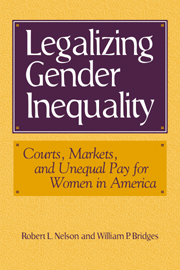Book contents
- Frontmatter
- Contents
- List of Figures and Tables
- Acknowledgments
- 1 Law, Markets, and the Institutional Construction of Gender Inequality in Pay
- Part I Theory and Method
- 2 Legal Theories of Sex-Based Pay Discrimination
- 3 Toward an Organizational Theory of Gender Inequality in Pay
- 4 Methodological Approach: Law Cases, Case Studies, and Critical Empiricism
- Part II The Case Studies
- Part III Conclusion: Legalizing Gender Inequality
- Appendix: Court Documents and Case Materials Used in Case Studies
- References
- Index
2 - Legal Theories of Sex-Based Pay Discrimination
Published online by Cambridge University Press: 07 August 2009
- Frontmatter
- Contents
- List of Figures and Tables
- Acknowledgments
- 1 Law, Markets, and the Institutional Construction of Gender Inequality in Pay
- Part I Theory and Method
- 2 Legal Theories of Sex-Based Pay Discrimination
- 3 Toward an Organizational Theory of Gender Inequality in Pay
- 4 Methodological Approach: Law Cases, Case Studies, and Critical Empiricism
- Part II The Case Studies
- Part III Conclusion: Legalizing Gender Inequality
- Appendix: Court Documents and Case Materials Used in Case Studies
- References
- Index
Summary
The decisions of federal courts in cases alleging sex-based pay discrimination reflect the tension between the law's normative commitment to equality and the courts' reverence for markets and efficiency. County of Washington v. Gunther (452 U.S. 161 [1981]), the Supreme Court ruling that fostered comparable worth litigation in federal courts, can be seen as a response to the antidiscrimination imperative. The Court would not countenance blatant discrimination against women workers just because they held different jobs from the male workers with whom they were compared. In the cases that followed Gunther, however, the lower courts limited its practical effect. They rejected comparable worth theories that relied on job evaluation studies to prove discrimination or that argued that employers were obligated to correct inequities identified in job evaluation results. Moreover, they consistently found that between-job pay differentials reflected market wages or acceptable business judgments rather than invidious, gender-based policies. The courts rendered these judgments case by case. Yet the opinions contain either sweeping references to the “economic realities” confronted by employers or only the most cursory analyses of market conditions. Our reading of the opinions is that the final outcomes of these cases were influenced by a deeply held, promarket ideology that may have extended beyond the facts in particular cases.
Much of the rest of this book examines whether the courts' belief in markets and efficiency as the primary determinants of the male-female wage gap is well founded empirically. The focus of this chapter is the law itself.
- Type
- Chapter
- Information
- Legalizing Gender InequalityCourts, Markets and Unequal Pay for Women in America, pp. 25 - 52Publisher: Cambridge University PressPrint publication year: 1999



